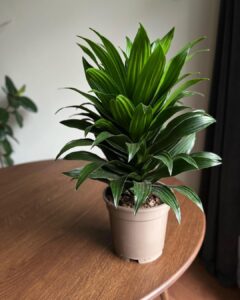Read in detail about the Proven Dracaena Plant Benefits and Growing Tips in this guide, and include this beautiful plant in your collection.
Discover the Proven Dracaena Plant Benefits and Growing Tips to make these plants thrive in your home. Enjoy healthier surroundings and a touch of nature’s goodness with Dracaena plants.
Read Costus Igneus Uses and Benefits
Dracaena Plant Profile

Family: Dracaena belongs to the Asparagaceae family, which includes other well-known plants like asparagus and lily-of-the-valley.
Native Place: Dracaena plants are native to various regions worldwide, including parts of Africa, Asia, Northern Australia, and Central America. They can be found in tropical and subtropical areas.
Appearance: Dracaena plants are known for their striking and diverse appearance. They have long, slender leaves that can vary in color and pattern. Some have solid green leaves, while others exhibit stripes or edges of white, yellow, or red. The leaves can grow in clusters at the top of tall stems.
Dracaena Plant Benefits

1. Air Purification
One of the most well-known benefits of the Dracaena plant is its ability to purify the air. They effectively remove indoor air pollutants like formaldehyde, benzene, xylene, and trichloroethylene. These pollutants can be released from common household items like furniture, carpets, and cleaning products. Dracaena plants absorb these toxins through their leaves, helping to create a healthier indoor environment.
The NASA clean air study found that the dracaena plant can help clean the air by absorbing various pollutants to some extent.
2. Improved Humidity
Indoor environments can often have low humidity levels, especially in heated or air-conditioned spaces. Dracaena plant releases moisture through a process called transpiration, which benefits by increasing the humidity around them. This can be particularly effective for people who suffer from dry skin or respiratory issues.
A study by the Agricultural University of Norway showed that having houseplants in offices led to fewer cases of colds, dry skin, dry coughs, and sore throats among office workers.
3. Reduced Stress
A study highlights the remarkable benefits of indoor plants, particularly the Dracaena plant, in our lives. Spending time with these plants has been shown to have positive effects, including reducing cortisol, a stress hormone, in our bodies.
The presence of indoor plants like Dracaena can benefit by reducing stress and improving mental well-being. The greenery and natural elements can create a calming and soothing atmosphere, making spaces more inviting and relaxing.
4. Enhanced Productivity and Creativity
Studies have suggested that having plants in workspaces can enhance productivity and creativity. The presence of plants like Dracaena can improve concentration, boost mood, and contribute to a more pleasant work environment.
A study proves that having Dracaena marginata and a few other indoor plants around the university helps students improve their concentration and focus.
5. Noise Reduction
Some research indicates that indoor plants, including Dracaena, can help absorb and dampen noise, creating a quieter environment. This can be particularly valuable in office settings or spaces where sound insulation is necessary.
6. Low Allergenic Potential
This amazing plant releases oxygen, reduces CO2 levels, and sucks up harmful chemicals (VOCs).
Even if you already use air filters and purifiers, having Dracaena plant around benefits by adding an extra layer of defense. They ensure the air you breathe is as free from allergens as possible. Find out more about how plants combat allergies in this research study.
7. Long Lifespan
With proper care, the Dracaena plant offers benefits such as improved air quality and reduced stress. Regular maintenance, including leaf cleaning and repotting as needed, not only contributes to its health but also enhances its longevity.
8. Dracaena can Absorbs Lead (Pb)
Lead is a harmful metal that can cause serious health issues. If you swallow or breathe in lead, it can make you sick. Too much exposure can lead to problems like stomach pain, memory loss, and weakness. If you’re exposed to high levels of lead for a long time, it could even be deadly.
One big source of lead poisoning in the United States is dust in homes that contain lead. Lead can also move around through water and air. Dracaena plants, which you can grow indoors or outdoors, are useful for reducing lead levels.
Although there aren’t many studies on this topic, one study from Indonesia suggests that Dracaena marginata plants can absorb lead from the air and help make the environment cleaner.
Read Marigold Benefits and Uses in the Garden
Dracaena Plant Growing Tips

As you have read the Dracaena Plant Benefits and surely you will be craving to have this plant in your home, then here’s a simple guide on how to grow Dracaena plants in easy steps:
1. Find a spot indoors with indirect sunlight. Dracaena plants don’t like too much sun on their leaves.
2. Choose a pot that’s a bit bigger than the plant’s roots. Make sure it has a hole at the bottom for water to drain.
3. Use well-draining soil. Fill the pot about halfway with it. Put the Dracaena plant in the pot and add more soil around it. Press the soil gently so the plant stands up straight.
4. Water the plant when the top inch of the soil feels dry. Pour water slowly until it comes out of the drainage hole. Don’t let it sit in a puddle of water.
5. Dracaena likes room temperature, so no extremes of hot or cold.
6. Feed the plant with liquid plant food monthly during spring and summer. Follow the instructions on the bottle.
7. If the plant gets too tall or the leaves turn brown, you can trim them with clean scissors.
8. Some Dracaena varieties are toxic for pets, but it’s still good to keep leaves out of their reach.
9. Keep an eye on your plant and enjoy its growth. It might even surprise you with new leaves!
Note: Remember, every Dracaena variety may have slightly different care requirements, so it’s always a good idea to learn about the specific needs of the one you have.



